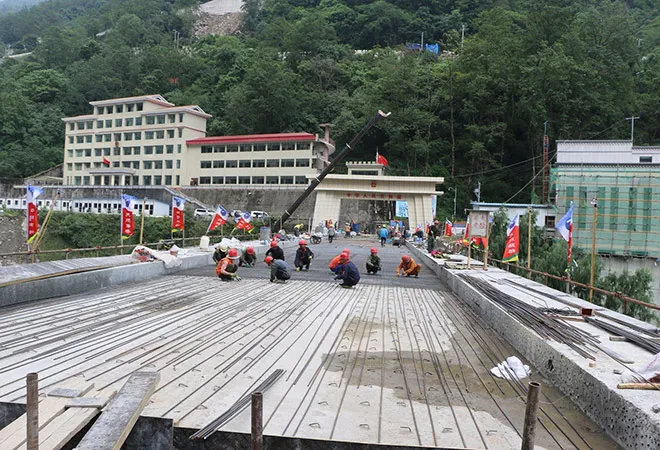
At a time when the relationship between Nepal and China is often held exemplary, media reports of a recent border-tiff between the two have attracted global attention. Primarily forwarded by a civil society group in the Himalayan country, the report alleges that China has constructed 11 buildings on the Nepalese terrain, in Lampcha village of Humla district (Namkha rural Municipality), bordering Tibet.
Although Nepal’s Ministry of External Affairs was very quick to deny the allegation, undercurrents of Nepalese resentment and protests, with slogans like “Stop Chinese Expansionism” cannot be denied, reminding of the existing, yet incognito, border disputes and encroachments.
Historical roots
The Sino-Nepal border is often denoted as a ‘controlled border system’ through an agreement of 1960, consequently leading to the border treaty of 1961, with the construction of the pillars of demarcation. The border is also marked by massive geographical structures like the Himalayan Range, several mountain passes, rivers and river valleys. Nepal also has had a historical linkage with the Tibetan Autonomous Region of China, dating back to the 7th century, facilitating transit for Buddhist monks and traders alike, to India.
It must be mentioned here that as noted by border expert Buddhi Narayan Shrestha, there were also several alterations of the traditional borders over time, owing to geographical remoteness, on the basis of convenience of small settlements as well as the give-and take-policy of the two countries. One of the many districts to be reshaped is Humla – specifically the north-western part, which looked like a mount towards the Chinese side but now has been pushed into Nepal.
All the changes in the boundary line can be witnessed after the treaty of 1961, mainly following a joint committee meeting and erection of 76 permanent border pillars in a harmonious manner. It has been found that Nepal had acquired 2139 sq km of land from China while conceding 1836.25 sq km of its existing territory to China, resulting in a net gain of 302.75 sq km for itself.
Present scenario
There are 15 districts, whose borders that Nepal shares with northern neighbour China with a borderline of 1439 km respectively. In the last decade, many vital border issues have emerged. The first issue is situated at the north of Lapchigaun in the Lamabagar area of Dolakha district. The controversy relates to the location of Border Marker Number 57 and six hectares of land.
The second issue revolves around the claims made by the Survey Department of the Agriculture Ministry of Nepal over the illegal Chinese occupation of Nepalese land spread over seven border districts, namely, Dolakha, Gorkha, Darchula, Humla, Sindhupalchowk, Sankhuwasa and Rasuwa. Additionally, the displacement of Boundary Pillar Numbers 35, 37 and 38 in the Gorkha district and Pillar Number 62 in Nampa Bhanjyang in Solukhumbu have been noted.
The first three pillars were supposedly a part of Rui village around the Tom River. Even though previous maps had denoted the areas as a part of Nepalese territory with the local people paying taxes to the Nepalese Government, it was occupied by China and merged with the Autonomous Region of Tibet in 2017. It has been often been argued that most of the areas that have been encroached are specifically catchment areas of rivers like the Bhagdare river in Humla, Kharane and Jambu rivers in Sindhupalchowk, Bhotekoshi and Samjug rivers in Sankhuwasabha.
Amicable path
There have also been allegation that the Nepal Communist Party (NCP) led by Prime Minister K.P. Sharma Oli has been shielding such encroachments by the Chinese Communist Party (CCP). Members of the Opposition Nepali Congress tried to move a resolution in the House of Representatives, the Lower House of Parliament, to take action against the encroachments.
However, the Government has stayed more or less quite on this issue, thereby giving rise to arguments that no such border dispute existed. It must not be forgotten that China is indeed the highest provider of Foreign Direct Investment (FDI) to Nepal (around 90 per cent of the total FDI received in Financial Year 2019-20), not to mention the negotiations completed on the basis of the Belt and Road Initiative of China, of which Nepal is a member and has been the recipient of uncountable benefits.
Under these circumstances, the Government might not be able to take full action against any border dispute as the economic cost of it would be too expensive for the landlocked country to pay, especially now that the times are uncertain due to COVID-19. Nonetheless, there were several protests and demonstrations outside the Chinese Embassy in Kathmandu, which may or may not yield results.
As of now, the both neighbours have decided to tread on an amicable path, thereby declaring that the bilateral relationship between them is steady and strong and that no such situation has emerged to disrupt the future engagements. In this scenario, how the prevailing yet curtained off disputes are resolved, if at all, remains to be seen over a period.
This essay originally appeared in South Asia Weekly
The views expressed above belong to the author(s). ORF research and analyses now available on Telegram! Click here to access our curated content — blogs, longforms and interviews.




 PREV
PREV


